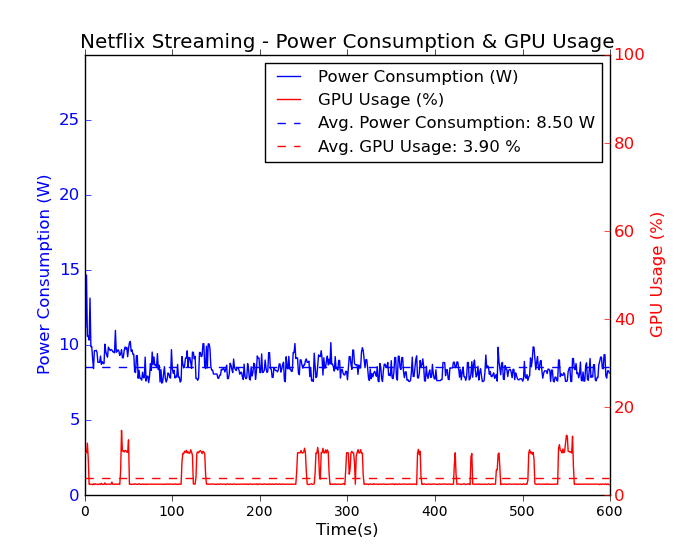Intel's Haswell NUC: D54250WYK UCFF PC Review
by Ganesh T S on January 3, 2014 4:25 PM ESTNetworking Performance and Streaming Aspects
In this section, we will take a look at the networking capabilities of the unit and also our standard HTPC streaming tests (involving YouTube and Netflix). Starting with this review, we are standardizing our evaluation of the wireless networking capabilities of UCFF and industrial PCs. Our standard test router is the Netgear R7000 Nighthawk configured with both 2.4 GHz and 5 GHz networks. The router is placed approximately 20 ft. away, separated by a drywall (as in typical US buildings). A wired client (Zotac ID89-Plus) is connected to the R7000 and serves as one endpoint for jPerf evaluation. The UCFF PC is made to connect to the two wireless SSIDs and jPerf tests are conducted for both TCP and UDP transfers with pre-set transfer parameters.
In our NUC build, Intel's Dual-Band Wireless-7260 delivers 2T2R 802.11ac speeds and provides very good throughput numbers when used with an appropriate router. As the gallery below shows, the 2.4 GHz band is able to deliver TCP throughput in the region of 86 Mbps and UDP throughput in the region of 96 Mbps.
The theoretical bandwidth number for 2x2 802.11ac is 867 Mbps. Practically, in the 5 GHz band, the 7260's TCP throughput is around 210 Mbps and UDP throughput is around 239 Mbps in our test setup.
Network Streaming Performance - Netflix and YouTube
YouTube and Netflix are two very popular streaming services utilized on HTPCs. With Windows 8, Silverlight is no longer necessary for Netflix streaming. The Netflix app on Windows 8 supports high definition streams (up to 5.8 Mbps) as well as 5.1-channel Dolby Digital Plus audio on selected titles.
It is not immediately evident whether GPU acceleration is available or not from the OSD messages. However, GPU-Z reported an average GPU utilization of 4% throughout the time that the Netflix app was playing back video. The average power consumption was around 8.5 W. Coming it at less than 10 W for the whole system while streaming HD video is very impressive. The spikes in the GPU usage were observed whenever the subtitles or control OSD kicked in. There is obviously some correlation between these spikes and the recorder power consumption at the wall.
One of the issues that I faced with the Netflix app was that bitstreaming HD audio (Dolby Digital Plus) would just not work. The playback was jerky to the point of being unwatchable and with either no or intermittent audio output to the AV receiver. Apparently, this is an issue faced by multiple users, and the problem stems from the Intel Display Audio Driver. Intel's rep on the forums, however, has been unable to reproduce the issue. So, it looks like many users are being left high and dry, unable to take advantage of one of the most important aspects of running Netflix as a Metro app.
Unlike Silverlight, Adobe Flash continues to maintain some relevance right now. YouTube continues to use Adobe Flash to serve FLV (at SD resolutions) and MP4 (at both SD and HD resolutions) streams. YouTube's debug OSD indicates whether hardware acceleration is being used or not.
Despite Windows 8 having plenty of YouTube apps, the browser interface is pretty much functional and free of external intrusive ads. The graph below shows the power consumption and GPU loading when playing a YouTube video in full screen using the Adobe Flash plugin on Mozilla Firefox.
The average GPU load is pretty constant around 8%, but power consumption at the wall has spikes corresponding to bursts of network activity. These bursts die down towards the end, after the full video gets buffered.
We saw that Haswell provided great power benefits for such network streaming activities in our HTPC piece at launch time. The Intel NUC takes this power benefit one step further by using a ULV processor. With a power consumption of less than 10 W for these activities, we are approaching dedicated media streamers' territory with the added flexibility of a full-blown PC at one's disposal.




















107 Comments
View All Comments
gochichi - Tuesday, January 7, 2014 - link
size of chassis is not the issue, it's never been the issue as can be clearly seen in the Mac Pro. What we need to look at is the particulars, the shapes and the size of the things that do matter to thermal efficiency. So if this thing had the fan that it should have in it due to its giant size (yes, I'm calling this NUC business GIGANTIC vs Surface Pro). I remember back in the day taking duct tape and sealing all the extra ridiculous vents on my desktop's case only to see noise and temperature reductions!! The idea that huge cases with a bunch of random vents are good thermal design is really wrong on so many levels. One well placed asymmetric fan is sufficient for a MacBook Pro... I'm just not understanding the general lack of expectations and standards. I expect so much more.SeanFL - Wednesday, January 15, 2014 - link
Just built one one of these and am very impressed. It's used for audio editing. Very very tiny and doesn't make much noise. I can't believe it's more powerful than the shuttle or fractal design mini itx I built last year. Hope to see more work being done in tiny form factor desktops.hellt - Thursday, January 30, 2014 - link
I think its crucial to specify that haswell NUCs are specified to use DDR3L memory according to spec sheet http://ark.intel.com/products/76978/Intel-NUC-Kit-...Some amazon reviewers got a problem with that - they bought DDR3 memory tweaked for overclocking (with higher voltages) and werent able to boot the nuc, because of the power insufficient.
kgh00007 - Tuesday, April 1, 2014 - link
Check this out, there are a set of 2133MHz G.Skill Ripjaws that will post on the i5 nuc, I'm about to order a set!http://www.legitreviews.com/gskill-ripjaws-8gb-213...
wordsofpeace - Saturday, February 8, 2014 - link
Maybe overkill, but wouldn't this board make a good basis for FreeNAS? What else would I need? SATA connections? How would that happen?kgh00007 - Tuesday, April 1, 2014 - link
Hi, are you guys aware that you can increase the TDP of the i5 model in the BIOS settings or using intel Extreme Tuning Utility?It is possible to up the TDP of the i5-4250u to 30w, which gives the GPU 24W and greatly improves performance.
Is there any chance you could re-run some tests to see the difference between 15W TDP and 30W?
feelingblue74 - Wednesday, August 6, 2014 - link
Someone can answer to this important questions?1) Can Haswell GPU output RGB Full 10bit?
2) Can Haswell GPU in DXVA Mode manage driver post processing (Sharpness and denoise) without dropping frames on 1080p@23.976?
3) How is Chroma upsampling quality?
4) How are banding?
5) Can Haswell output true 16-235 color space?